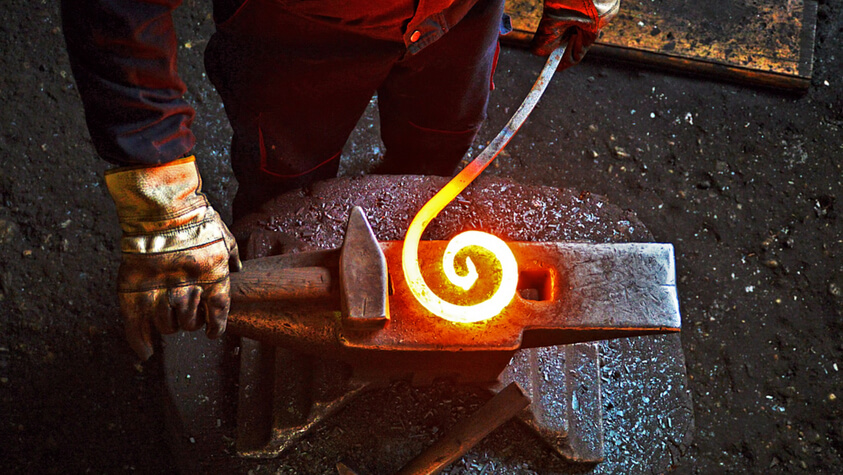By TACP Staff on July 07, 2021

When a creative yet pragmatic skill becomes functionally obsolete, it enters the realm of fine art. Such is the story of blacksmithing. Once an essential and vital trade, the blacksmith of today is free to allow passion to drive their creations. While some may choose to practice old traditions, others seek to expand the boundaries of artistic expression by exploring new techniques and applications for their art.
Blacksmithing refers to the art or process of shaping and forging metal with the use of heat and tools. From the time that civilizations discovered that metal could be forged, at least one blacksmith was present in nearly every town across the world. This metal shaping technique made it much easier to forge better weapons, tools, and building materials.
With the mention of the word “blacksmith”, the vast majority of people often conjure up images of men in the old West pounding out horseshoes. Blacksmiths not only made iron horseshoes, but they also forged and repaired weapons, tools, nails, screws, fences, and a variety of other items as well.
The Industrial Revolution, however, nearly put an end to the blacksmithing trade. New machines, like screw-cutting lathes, could produce metal goods much faster and cheaper than blacksmiths ever could. There were some jobs that machines couldn’t do, however, such as shoe horses, and although the number of blacksmiths in the word declined, they have not altogether disappeared. Today, blacksmithing is more of an art than a necessity, and the majority of modern blacksmiths now consider themselves to be artisans.
When these types of metal get to a certain temperature, they start to melt, or become molten. In order to forge metal, blacksmiths use tongs to heat it up in a furnace or fire until it is red hot. Although it is still technically a solid at this point, this makes the metal much softer and more pliable.
While the metal is easy to manipulate, a blacksmith will use a variety of different tools to shape and forge the metal. He can place the red hot metal on an anvil or metal bench, for instance, and hammer it flat. He can also use several other tools to twist it, bend it, pull it, or drill holes in it. The process of heating and shaping the metal is repeated several times until the metal has reached the desired shape.
Depending on a blacksmiths specialty, a variety of useful or artistic objects might be created during this process. Some blacksmiths forge tools, horseshoes, or decorative fences, for instance. Other blacksmiths may simple create decorative metal objects or sculptures.
Many modern blacksmiths start their careers as nothing more than weekend hobbies. They are self-taught, and they received no formal education. In fact, a formal education is not always necessary in order to have a successful blacksmithing career. Blacksmiths with a formal education, however, are generally more likely to have successful careers, and they are usually able to command higher wages.
Some technical and trade schools may offer degree programs in blacksmithing. While earning these degrees, aspiring blacksmiths will often learn a variety of different valuable skills, like metal forging and welding. Individuals who are looking to become a blacksmith should also consider an apprenticeship or journeyman program. These types of programs allow students to get hands-on blacksmithing experience while working under master blacksmiths.
The average annual wage of a blacksmith will vary, depending on how skilled he is, his location, and what he specializes in. Obviously, a very skilled blacksmith will be able to command a much higher wage than a mediocre blacksmith. Location will also usually play a part in a blacksmith’s wages; some areas have a higher demand for blacksmiths, therefore they will usually be paid more. Blacksmiths that work in structural metal fabricating made roughly $38,450 in 2017. Welders, cutters, solderers, and brazers, on the other hand, made roughly $40,240. The average annual salaries of self-employed blacksmiths, on the other hand, can vary widely. According to The American Farrier’s Journal, farriers that only work part-time can bring in as much as $20,000 a year. Ornamental blacksmiths may be able to make a living wage, depending on their skills and the demand for their creations, but there is no set data regarding the annual wages of these types of artisans.
A modern blacksmith will often be able to find employment with metal fabricators, factories, and manufacturers. The majority of blacksmiths, however, work as ornamental blacksmiths or farriers. Farriers are professionals that take care of horses’ feet. This does not just involve create horseshoes and shoeing horses, however. Farriers must also be able to trim horses’ hooves and also have a basic understanding of horse foot health. Ornamental blacksmiths, on the other hand, generally work in small shops. Many times, these shops will be owned and operated by one or two experienced blacksmiths. These types of blacksmiths typically create items for decorative purposes, like sculptures, but some of their crafts may also be useful as well. For example, blacksmiths can create handcrafted fireplace pokers, chandeliers, or weathervanes.
Consider these related careers in Craft and Fine Art.

The Art Career Project is a trusted resource for emerging and professional artists.